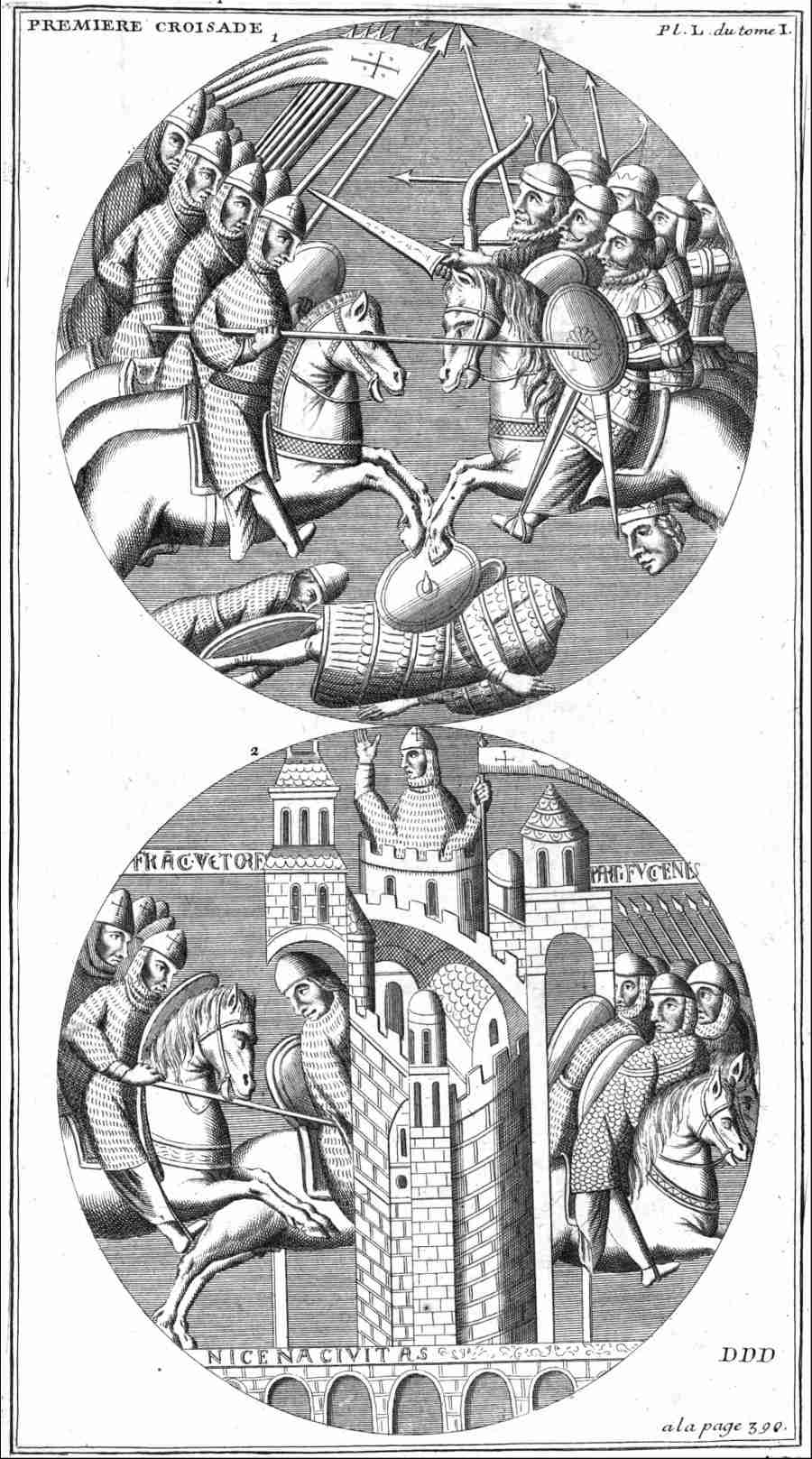
Try Amazon Audible Plus
Illustrations of Franks and Saracens of the 12th century
Les Monuments de la Monarchie Françoise
Qui Comprennent l'Histoire de FranceTome Premier
A series of 10 painted windows in the monastery church of St Denis in Paris
Plate L (50)
| PL. L. |
In the following plate, we see firstly the battle of Süleyman against the Crusaders placed on the window next to the one that represents the taking of Nicaea which we see at the bottom of the plate. In the first picture, the only one which has no inscription, the Crusaders are represented as combatants on horseback against the Turks. Their flag has a cross: they carry themselves the cross on their helmets. They are all covered with mail to the knee, which is also observed in other monuments of those times. The mail around their face & going to the underside of the helmet. Their shields have no coat of arms: which is also noticed in all the plates following. The coat of arms was not yet in use in that time, nor even at the time that Abbot Suger did make these windows. This certainly before the year of 1140. Since that year Suger after completing the Church, did make the dedication. The history is authentic as we can see in Duchene. Offensive & defensive weapons of the Infidels are seen here. Their cavalry have some bows, the other spears. Their helmet is only a callote. Their coat of armour is composed of small pieces, some with scales, others longer. The military dress of the Infidels varies greatly in the other pictures. The picture below represents the capture of Nicaea which surrendered by capitulation. The crusaders enter through a door and the Turks leave by another. Their dress is a little different from that of the previous picture. This is apparently only a play by the painter that a Crusader pierces with his lance a Turk on horseback in the city. Another Crusader as the top of a tower has already raised the banner of the cross. The inscription below is Nicena civitas, the city of Nicaea. At the sides at top is that of Franci Victores, Parthi sugientes. The French conquerors, the Parthians beaten. The Turks & Infidels are almost always called the Parthians on these windows. An Author of Gesta Francorum also mixes the Parthians among those who waged war against Crusaders, as we can see p. 564 & 569. The Parthians were once viewed for many centuries as the "Eastern Empire", in Roman History in fact the usual reference, and that is why they are called this in preference to others. |
 A larger image of Plate 50, print of a Monastery Church of Saint Denis window of the 12th century | |
| PL. L. |
Dans la Planche ſuivante, on voit premierement le combat de Soliman contre les Croiſez mis ſur Ia vitre á côté de celui qui repreſente la priſe de Nicée qu'on voit au bas de la même Planche. Dans le premier tableau, le ſeul qui n'a point d'inſcription, les Croiſez font repreſentez combattans à cheval contre les Turcs. Leur drapeau a une croix : ils portent eux-mêmes cette croix ſur leurs caſques. Ils ſont tous couverts de mailles juſqu'aux genoux; ce qui s'obſerve encore dans d'autres Monumens de ces tems-là. Ces mailles leur entourent le viſage & vont juſqu'au deſſous du caſque. Leurs boucliers n'ont point de blaſon : ce qu'on remarque auſſi dans tous les tableaux ſuivans. Le blaſon n'étoit point encore en uſage en ce tems-là, ni même au tems que l'Abbé Suger fit faire ces vitres. Ce ſur certainement avant l'an 1140. Puiſqu'en cette année là Suger après avoir achevé l'Egliſe , en fit faire la dédicace. L'Hiſtoire en fait foi comme on peut voir dans Duchêne. Les armes offenſives & défenſives des Infideles ſe voient ici. Leurs cavaliers ont les uns des arcs , les autres des lances. Leur caſque n'eſt qu'une callote. Leur cote d'armes eſt compoſée de petites pieces, quelques-unes à écailles, d'autres plus longues. Cet habit militaire des Infidels varie beaucoup dans les autres peintures. Le tableau ſuivant repreſente la priſe de Nicée qui ſe rendit par capitulation. Les croiſez entrent par une porte & les Turcs ſortent par une autre. Leur habit eſt un peu different de celui du tableau précedent. Ce n'eſt apparemment que par un jeu du Peintre qu'un Croiſé perce de sa lance un Turc qui entre à cheval dans la ville. Un autre Croiſé fur le haut d'une tour a déja arboré l'étendart de la croix. L'inſcription d'en-bas eſt Nicena civitas , la ville de Nicée. Celle d'enhaut eſt Franci victores , Parthi ſugientes. Les François vainqueurs, les Parthes qui ſuyent. Les Turcs & preſque tous ces Infideles ſont appellez Parthes ſur ces vitres. Un Auteur des Geſta Francorum mêle auſſi les Parthes parmi ceux qui ont fait la guerre aux Croiſez, comme on peut voir p. 564. ¤ 569. Les Parthes ont autrefois tenu pendant pluſieurs ſiecles l'Empire d'Orient , l'Hiſtoire Romaine en fait ſouvent mention , & c'eſt pour cela qu'on les nomme ici par preference aux autres. |
Next
A Frankish Knight c. 1097 in Armies and Enemies of the Crusades 1096-1291 by Ian Heath, based on this painted window in the monastery church of St Denis in Paris.
Back to the series of 10 painted windows in the monastery church of St Denis in Paris